Michael Pronko's Blog, page 7
July 11, 2019
The End of Tokyo Homes
Every couple of weeks, as I ride my bike to the station, I come across a home split open. Along the way, I see stately traditional homes chewed up by backhoes, spit into trucks and hauled away. I risk being late to work to watch walls and posts topple, roofs collapse, concrete foundations get jackhammered as another home is broken to pieces small enough to haul away on a flatbed. I feel like I’m witnessing a crime.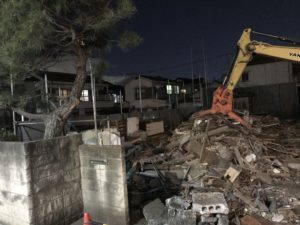
All I’m really witnessing is the Tokyo process of re-dividing land. Old homes with gardens are too much trouble for young people, so they’re sold off, ripped down and the lot subdivided. The economics doesn’t interest me. It’s the process I can’t take my eyes off of.
Wall after wall is smashed and splintered and the guts of houses I’d ridden by for years are exposed. You can see what was long hidden—the inner stage for the dramas of bedroom and kitchen, the relaxation of tatami and bath, the secrets of closet and toilet. All are left hanging out like morning wash for any passerby to ogle.
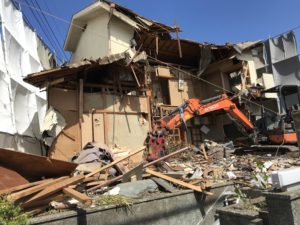
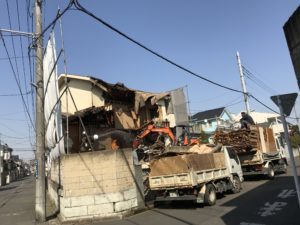
It’s mesmerizing to witness the interior become exterior, the construction put on rewind and the walls that protected one family’s world stripped away. It’s hard to not want to see the end, violent as it is, of something so private and special. The creaking and shredding of walls and staircases and balconies and floors seems to be the last noises of a generational home.
In one Toshiro Mifune film, he gets revenge on a rice-hoarding landlord by taking out the central pillar of his storehouse with a single swing of his sword. The roof and walls collapse and starving peasants surge in. I laughed the first time I saw that film, not believing it. But now I know it’s true. It’s not one sword cut, of course. It is a week of backhoe thrusts, a bit of yanking and tearing, along with some well-aimed hammering. And it’s over.
Most of the glass windows and wire guts have been removed before the real action gets underway. Pictures, decorations, furniture, tatami mats are left in place, not to mention toilets, plumbing and bathtubs, the metal of which crumples up like silver paper. The tile roof, which is heavy and dangerous, and no doubt a pain to clean up if shattered, is tossed hand to hand down to the truck. Once all that’s gone, a Japanese home is not much more than wood and memories.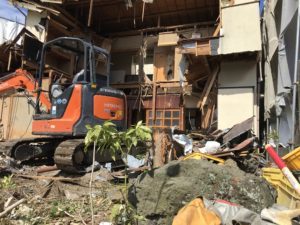
As other Japanese hurry past, I rationalize my staring as cultural study. It is rare in Tokyo to go into other people’s homes. Entertaining is done outside, at bars or restaurants, rarely at home. I’ve been to one or two of my Japanese colleagues’ homes, but not many. Looking inside homes or offices from the train lets you see for a passing second. But you never get to fully indulge your eyes, or imagination.
To answer Robert Frost’s famous poem, something there is that doesn’t like walls down, too, that doesn’t want the inside exposed, the past splayed open. It’s like seeing time reversed, a bed sheet pulled back, a door opened too soon. It’s obscene in a way. People stare at me taking photos of the destruction, silently scolding me, I guess, that I should have more respect for the dead.
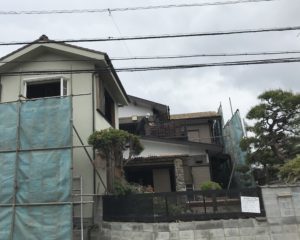
But I do have respect. It’s just that it’s fascinating to watch the backhoe attachment eating its way through the house like a giant, metal termite. In collapse, the homes appear to be nothing more than dust and sawdust held together by some old spell. There is so much dust one worker sprays water to keep it from drifting around the neighborhood. The unique smell that every home has from cooking, bodies, pets, sprays and—in older homes—mold, is lifted into the air and disperses.
I’m always intrigued by the skill, and daring, of the workers. The driver works the controls like a jazz drummer, moving forward to crunch through a section of wood, backing off to let it drop, surging forward to pick it up, all the while shifting the wheel tracks. With the pincher teeth, they can pick up a strong beam to whack down ceilings, buckle a staircase and bust through an inner wall. The stackers set wood boards and beams on the trucks like a too-easy puzzle.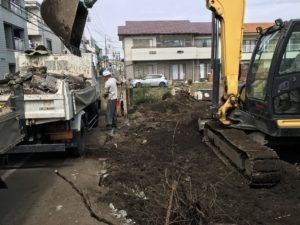
One rainy morning, I asked a team of two stackers and one backhoe operator if it was OK to take photos. They laughed and waved OK. As I took photos, the backhoe operator smiled from inside the cab and showed off by delicately picking up a single board and placing it precisely on top of the stack. In fact, they use only as much force as needed, moving everything meticulously, and delicately.
I asked the guy in charge of stacking the wood how long one home took. He told me most homes took about a week. The materials had to be carefully separated into insulation, metal, concrete, and wood. The tatami mats are often slipped under the treads for traction. I asked where he recycled everything, wondering what you’d get for all the materials. He looked confused. “It’s all gomi (trash),” he told me, gesturing from atop a neat pile of wood on the truck bed. Then he got back to work.
It must be a sad job, I felt, snagging abandoned furniture, bathtubs, sinks, fixtures and the occasional abandoned painting. I wondered whether the workers imagined, as they worked, the conversations, laughs and cries, the arguments, celebrations, dinners, baths and expressions of love that must have taken place inside that home. I wanted to ask them how they felt, what they’d seen, or if it was just a job. But I didn’t ask. I maybe didn’t want to know.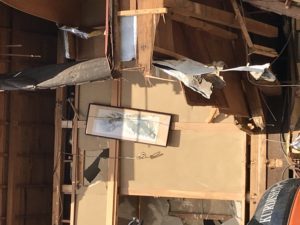
Instead, I rode off on my bike wondering if once the last board of wood is stacked, the dirt packed in place and the public road hosed down, whether anything remained to remember the lives lived there. It couldn’t all be gomi. But in Tokyo, it’s the land that holds value, not the past lives or the old buildings.
After that I always ride by in the following weeks, glancing anxiously at the dirt, waiting for signs of the groundbreaking ceremony. I’ve never chanced on an actual ceremony, in which a Shinto priest sets up a ring of bamboo, rope and washi paper, with a symbolic wooden hoe, sacred sakaki branches, and other offerings. Those are taken away after the ground is purified and spiritually readied.
But left behind always is what looks to me to be a sprig of rice in a small mound of dirt, from which another home, another set of lives, will grow there again.
Michael Pronko, July 11, 2019
February 16, 2019
November 24, 2018
Autumn Hanami
Cherry blossoms must be the most commonly painted, printed and loved image in all of Japanese aesthetics. Cherry blossoms pop up all year round on everything from T-shirts to chopstick wrappers to wallpaper. Universally and deeply loved, hanami flower viewing parties under the cherry blossoms seems to energize Tokyo like nothing else. However, there is another spectacular explosion of color in Tokyo that is often overlooked. Every fall for a couple of weeks, Tokyo’s maple trees burst out in red. This maple-viewing is a very different experience from the spring hanami, but one that transforms Tokyo in just as powerful of ways.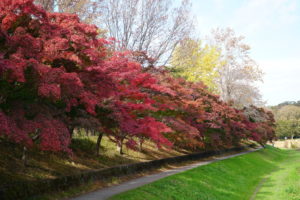
This fiery autumnal answer to the spring’s cherry blossoms is less bold, joyous and friendly than the cherries, but they are just as impressive in their own way, even if they are less noticed. Once autumn arrives, Tokyoites hurry along in heavier coats instead of stripping off their neckties and heavy blouses to loll around in April’s fresh splendor. The maple leaves will probably never be as openly loved as cherry blossoms because they are easier to miss. When the daylight is abbreviated and darkness falls early, Tokyoites start to hunker down, pull up their collars and look around less, facing inwards, compared to the extroverted pleasures of the spring.
The autumn’s maple trees are just as common and colorful, though. Like cherry trees, they are often planted together, but they never seem to conform to a total group effect, but stand individually. They are often hidden behind other plants, leaning over bushes and spurting up behind other trees. Scarcely distinguishable the rest of the year, the maples take over after waiting patiently for the locust and gingko to drop their yellow. Then, as if to prove patience and stamina, and a keen sense of timing, the maples erupt everywhere.
Once they are out, maples have a rough kind of beauty. The branches fall into unique cut-out shapes that fall into parallel layers of irregular branches. The maples not really very elegant, curved or smooth; they are more of a jerky folk dance than the fluid ballet of cherry trees. The cherry trees seem perfectly adapted to their Tokyo homes along canals, wide sidewalks, and throughout parks. Maples, though, seem a little awkward, not quite fitting in. When their leaves fall, it feels final and decisive, not like the next stage of fun when cherry blossoms whiten the ground or blanket a green canal in pink.
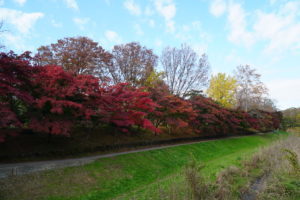 The maple red feels more adult, pensive and serious than the cuter, younger pink and white of cherries. Never just a pure red, though, each maple tree has its own individual, description-defying color. The base red is always mixed with a little green at the edges, a layer of purple, a stroke of orange in the middle that makes the hue sharper, almost electric. Maple leaf red has a powerful, natural glow that comes from the eye moving between the green-orange-purple-red and finally a little gray on the back side, to pull in a shimmering constellation, a full spectrum, of redness.
The maple red feels more adult, pensive and serious than the cuter, younger pink and white of cherries. Never just a pure red, though, each maple tree has its own individual, description-defying color. The base red is always mixed with a little green at the edges, a layer of purple, a stroke of orange in the middle that makes the hue sharper, almost electric. Maple leaf red has a powerful, natural glow that comes from the eye moving between the green-orange-purple-red and finally a little gray on the back side, to pull in a shimmering constellation, a full spectrum, of redness.
Tokyo is usually so colorless. Few Tokyoites would buy a coat, a car, or a sofa with the intensity of maple red. Pink and white is reproduced all year round, but the complex maple colors you see only on the trees. Yet, it is this complicated, variegated aspect of maple red that creates their appeal. They have dignity, and a hint of melancholy, compared to the splashy, crowded throb of cherry blossoms. Maple leaves fit small, isolated temples, where the only sound is the faint crinkling of leaves; cherry trees fit big parks of rollicking, noisy party sounds. Tokyo’s character encompasses both moods, though it is easier remember the parties.
But, to stop and gaze up at the vibrant potency of the maple leaves’ color before catching the train home to a haphazardly heated apartment is to enter a moment of surreal beauty. We linger over the cherry blossoms, sitting for hours or walking until our feet hurt, but maple leaves we look at more quickly, with more immediate and penetrating effects. The dark reds and deep purples glow so strongly it is hard to look at them for long. They are dazzling. A quick glance is all that is needed before hurrying on.
We look at cherry trees in groups, but maples alone. Perhaps it is that experience of seeing them alone that frightens most Tokyoites off from looking more. Tokyo is lonely city in so many ways. That’s the pleasure of spring hanami: to see so many other people, all out of winter hibernation, all together, all in a good mood. You feel part of something bigger. But the maple leaves remind us of our singular existence, a reminder that most Tokyoites hardly need.
Cherry trees reaffirm one side of life in a big city–the noise, the people, the openness, the belonging, and the fun. Maple trees, though, remind us of more complex, enigmatic meanings and deeper, moody reflections. They remind us that Tokyo life has many aspects, but that one of our deepest, if most often ignored intuitions is that our place in the city is always also, in part, alone, or at least alone with a maple tree’s dignified beauty for solitary comfort.
(This was one of the very first pieces I wrote about Tokyo, over a dozen years ago. It appears in the second collection, Tokyo’s Mystery Deepens. It’s available from my website here and from online bookstores, too. It’s always been one of my favorites.)
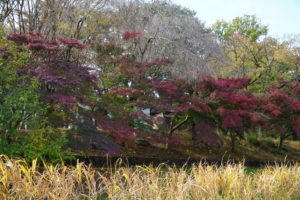
November 15, 2018
Feathered Quill Interview
 Author Interview: Michael Pronko
Author Interview: Michael Pronko
Today, Feathered Quill reviewer Lynette Latzko is talking with Michael Pronko, author of The Moving Blade
FQ: What is the significance of the menacing statue on the cover of The Moving Blade?
PRONKO: Menacing and protective, that’s Fudo Myo-o. The god has many meanings, but the name translates as something like “unmoving, shining king.” He is a guardian deity, with a sword of wisdom to cut through ignorance and a lariat to tie up demons. Encountering a huge statue of him in a dark temple can really jolt you out of the everyday and spellbind you. The deity has many variations stretching back to China and India, but in Japan, he is often thought of as one of the gods that protects Tokyo, and old Edo. There is a series of temples devoted to him in Tokyo. To me, he encapsulates the lurking violence, good and bad, in human experience.
FQ: How has your writing improved or changed since your last book, The Last Train?
PRONKO: I think it’s more the process of writing has improved. That’s what I focus on. For example, I upped the rewriting. With each rewrite, I focused on one particular point, character, connection, suspense. That’s not just fiddling with the words, it’s rewriting by rethinking, reworking, reconceiving, reconnecting. Because I wanted to tell a slightly different kind of story this time, I had to create not just one character’s background, but an entire range of back stories flowing through the history of American and Japanese relations. Spending time on that, I think, helped tell a stronger story.
FQ: Did you complete any research while writing this novel? And if so, what was the most critical thing you learned from this research?
PRONKO: I read a lot of history about the United States and Japan since World War II. While working at The Japan Times for years, I had seen most of the contemporary issues in recent years. It’s a relationship with a lot of subtle entanglements and unresolved issues. But those are hard to distill and squeeze into a novel. In this age of facile politicizing, it’s also easy to indulge in snap judgements and knee-jerk analysis. And I confess I sometimes, often, do that on my own time, but in a novel, that doesn’t get you too far. It feels good to let loose, but it’s not interesting to read. A novel is more about how people live with the conditions and situations that surround them. That is interesting. So, I guess I learned to cut out all the research and personal opinions by the final draft.
FQ: I read that some famous authors have writing rituals like fellow mystery/thriller writer, Dan Brown, who supposedly hangs upside down using anti-gravity boots to help him relax. Do you have any specific habits or rituals when you are writing?
PRONKO: Writing is already like hanging upside down—reversing, upsetting, pumping too much blood to the head. Nothing more like that for me, thanks. I do write, or usually rewrite, on the Tokyo train. When I can get an elbow free. Something about the motion lets me think freely. And Tokyo trains are filled with people reading, which I take as encouragement. If I get a seat, which is rare, I rewrite on printouts of the last chapter. If not, and there’s room, I write standing. If it’s too jammed for that, I’ll just think through a plot point, then scrawl it down or put it on a voice recorder once I get off the train. Other than that, the basic ritual is butt in chair in morning.
FQ: If the Detective Hiroshi mysteries were to become a movie, what actor do you envision playing the detective?
PRONKO: I like the actors from 1950s films, Toshiro Mifune, Takashi Shimura, Ken Takakura, Tatsuya Nakadai, but that’s just a dream list now, sadly. Some current actors like Hidetoshi Nishijima, Yosuke Eguchi, and Hideaki Ito are compelling, and have done similar roles. Koji Yakusho is always great. Shinichi Tsutsumi would fit Detective Hiroshi perfectly. I’m not sure how well known those actors are outside Japan, but they should be.
FQ: I noticed that in both books of this series your victims are American men. Is this done purposefully, or is it a mere coincidence?
PRONKO: Is that me killing off my American side? Some latent self-pity, or secret suicidal impulse? Hmm, I wonder. But, maybe not. I sketched out several novels for this series, so these two just happened to be the first ones that came together concretely. There were Japanese killed in those novels, too. In the next novel, there are no Americans at all, and in the one after that, the killer is American and the victim Japanese. So, half-coincidence, maybe?
FQ: One of the subjects mentioned in The Moving Blade refers to the SOFA agreement between the US and Japan. Do you believe that the US will ever fully remove its military presence in Japan?
PRONKO: I doubt the US will ever fully remove its military presence from the world! For one thing, decommissioning 800 bases in 70 countries would take a lot of logistics and a lot of budget. It might happen that the US scales down or consolidates some of the bases, but the military presence in all these countries will continue for the near future. The arguments for and against the US presence in Japan are very complex. But, at least, it’s important that Americans and Japanese know and think about where their tax dollars are being spent. Whatever one’s opinion, it’s important that the American military presence not be downplayed, concealed or ignored.
FQ: Now that you have two great mystery novels under your belt, what advice would you give new authors who are considering writing in this genre?
PRONKO: Genre can be demanding, even tyrannical. People like to know what they’re getting ahead of time, and genre helps with that, but delivering too much of what people “like” is not always good. I think of genre as a recipe. Whenever I use a recipe, though, my kitchen never has all the right ingredients, and after a glass of wine, or two, I ease away from preparation techniques and start improvising. If the food comes out right, that’s all that matters. The nice thing about a novel, compared to dinner, is that if it’s not right, you can redo it or throw it out. I like the mystery genre because so much variation is possible. Almost anything could, conceivably, fit inside. That’s a lot of room to work, so new authors, and old ones too, should work with that room. So, the tightness of the genre should be respected and the looseness explored.
FQ: In our last interview you mentioned this current book, and another book in The Detective Hiroshi series. Will the series definitely end with the trilogy, or have your writing plans changed?
PRONKO: It won’t end at three. The next one, Tokyo Traffic, is now being rewritten. That will be followed by two more in this series, which are sketched in already. I want to do a standalone with Sakaguchi, the ex-sumo wrestler, and a prequel with Takamatsu. After that, I have a few other books in mind, though, too. And I’d like to get back to writing some essays about Tokyo again, too.
FQ: After finishing this second novel in the series, I have a few unanswered questions, and am curious to learn more about Detective Hiroshi Shimizu. Can readers look forward to learning more personal details about the detective in your next novel?
PRONKO: In the next one, Hiroshi has moved in with his long-lost girlfriend and much comes out about his inner world and about his past. I don’t want to let out everything about him too soon, but as he opens up to her, we learn more about him! So yes, more to come, a few more questions answered, a few more posed, about Hiroshi, Tokyo and the constant undertow of crime.
October 24, 2018
Awesome Gang interview

Tell us about yourself and how many books you have written.
I’ve written five books, but it depends on how you count. I published three in Japanese, then two of those in English, one new collection of writing about Tokyo, and now two mystery/thriller novels. The third in the series is “written” but not rewritten (so not really written).
What is the name of your latest book and what inspired it?
The Moving Blade has many inspirations. Mostly, the ideas come from living in Tokyo. I worked in the editorial section of The Japan Times, so that got me thinking about politics and how that intersects with people’s personal lives. I was also influenced by many of the old Japan hands, and China hands, I’ve met. Those older people were the basis for the character of Bernard Mattson. Originally, the book centered on him and his experiences, but by the time I finished it, the book starts out with his funeral.
Do you have any unusual writing habits?
Writing itself is an unusual habit, I would say. I love rewriting on the trains of Tokyo. Somehow the motion and the crowd really gets me to focus on the words. I can hear them in my head and make the sentences really sing like I want them to. Most of my good ideas come to me when I’m on the train, so I keep a notebook to jot them down, and a voice recorder for when I get off the train. Train time in Tokyo adds up.
What authors, or books have influenced you?
So many I can hardly list them. I’m always intrigued by the hard-boiled writers, Chandler, Hammett and Cain (the holy trilogy). James Ellroy, Cornell Woolrich, Jim Thompson, Elmore Leonard. That’s not to say I write like them, but I find their stripped-down prose and unstoppable momentum fantastic. I also teach American Literature at university, so authors like Kurt Vonnegut, Cormac McCarthy, Ernest Hemingway and also American poets have a real grip on me.
What are you working on now?
The third in the Detective Hiroshi series. Tokyo Traffic. It’ll be rewritten and released by spring of 2019.
What is your best method or website when it comes to promoting your books?
Well, there’s promotion and promotion. I like some sites which let my work come out as it is, but others are pure contact with lots of readers, so it’s always a balance.
Do you have any advice for new authors?
Write every day. Rewrite every day. Read and learn from everything. Shed that overly romanticized skin and just get down and do the work.
What is the best advice you have ever heard?
It may be apocryphal, but one guy protesting at college said that the Navajo Indian tribe had a saying about the two basic rules of life: Try to be kind to everyone and try to understand everything. Sounds like a great goal to me.
What are you reading now?
I have things stacked so tall on shelves in my office, by my reading chair, by my bed, and for classes I teach, I can’t even keep track. I always have a page dog-eared in a dozen or more books, and a dozen more half-read in my e-reader.
What’s next for you as a writer?
I’ll finish the Detective Hiroshi series, and then I’ll do a couple of stand-alones, also set in Tokyo. I’m keeping notes on two works of non-fiction, too, one about Tokyo and another about teaching. We’ll see which ones scramble to the surface first.
If you were going to be stranded on a desert island and allowed to take 3 or 4 books with you what books would you bring?
Zorba the Greek, Slaughterhouse Five, Dickens (I’d have to argue out which one…), Plato (I was a philosophy major). Agh, that always breaks my heart to have to think like this. Forgive me, other writers, I want to bring your works, too!
October 20, 2018
A Different Kind of Curiosity Interview with Literary Titan
Posted by Literary Titan
Michael Pronko Author Interview
The Moving Blade follows detective Hiroshi as he navigates street level politics to solve the murder of an American diplomat. What was the direction that you wanted to take book two in the series that was different from book one?
The direction I wanted to take it is not the direction it ended up going. So, I headed more into the characters, who became more and more interesting. I focused on the roiling tumble of conflicts inside them, and what that might reflect of social, political and historical conflicts outside. I think that’s similar to book one, but because the characters are embedded into a larger framework of political pressures and international relations, their actions resonate differently. The canvas is broader in this second book, and I go deeper into Tokyo, to see the background of the characters and their choices, good and bad.
I enjoyed the mix of interesting characters throughout the novel. Who was your favorite character to write for?
I like all of them. Well, I don’t like the bad guys, but I like hating them. My favorites were maybe the bookstore owner twins and the radical leftist. They were fun to write and to put in scenes together, the twins steady and demure and the leftist stridently angry. Sakaguchi, the ex-sumo wrestler, is always fun to write for. He has this core set of values that is rock solid Japanese. When he explodes, he really explodes. And of course, Hiroshi developed and grew as a person and as a detective, in perhaps meandering ways, but human ways. The women characters are great to write for, too, as they pull the story in their direction.
It quickly unfolds that the missing manuscript was the driving factor behind the diplomat’s death. How do you balance storytelling with mystery and action to ensure readers are engaged to the very last page?
Among all the different types of mysteries, whodunnits, whydunnits, I-dunnits, I didn’t-do-its, I tend towards the why. Maybe because I was a philosophy major? Not-knowing who creates a different kind of curiosity than not-knowing why. Withholding certain pieces of information is essential. As Alfred Hitchcock pointed out, if you know there’s a bomb under the table, but the characters don’t…well, that’s suspense. And if you don’t know why the bomb is under the table in the first place, it’s really intriguing. As jazz musicians often say, and I think Mozart said it originally, the music is not in the notes, but in the silence between. I think writing should be aware of what’s not spoken, what’s not known. The unknowns make you lean in and pay attention.
Where will book three in the Detective Hiroshi series take readers?
Book three is called Tokyo Traffic. The story revolves around a young Thai girl who gets lost in Tokyo, after running away from some horrible people. She is rescued by a young Japanese woman who lives in an internet café and plays in a rock band. Most of the story takes place in the nighttime youth hangouts in Shibuya and Shimokitazawa, another side of Tokyo. The detectives are the same, though Hiroshi has moved in with his college girlfriend and Takamatsu is off suspension. It goes deeper into the characters and deeper into Tokyo.
When the top American diplomat in Tokyo, Bernard Mattson, is killed, he leaves more than a lifetime of successful Japan-American negotiations. He leaves a missing manuscript, boxes of research, a lost keynote speech and a tangled web of relations.
When his alluring daughter, Jamie, returns from America wanting answers, finding only threats, Detective Hiroshi Shimizu is dragged from the safe confines of his office into the street-level realities of Pacific Rim politics.
With help from ex-sumo wrestler Sakaguchi, Hiroshi searches for the killer from back alley bars to government offices, through anti-nuke protests to military conspiracies. When two more bodies turn up, Hiroshi must choose between desire and duty, violence or procedure, before the killer silences his next victim.
THE MOVING BLADE is the second in the Tokyo-based Detective Hiroshi series by award-winning author Michael Pronko.
October 16, 2018
US Review of Books
The Moving Blade: A Tokyo Mystery
by Michael Pronko
Raked Gravel Press
by Kat Kennedy
“When Jamie Mattson saw her father for the first time since she was thirteen, he lay in the casket in the Shida Funeral Hall and Crematorium.”
Jamie Mattson’s reunion with her father in Tokyo isn’t what she expected. Just one week before she is to leave for a visit with Bernard Mattson, she receives word that her father has died. Now, in Tokyo, she learns he was murdered. Left to deal with the police inspectors, the U.S. Embassy, and, most daunting of all, the work her father left behind, Jamie is determined to discover why her father was killed. When detective Hiroshi Shimizu becomes involved with the case, he offers Jamie his personal help. Soon after they begin to uncover Mattson’s work, it becomes apparent that it holds the key to his murder, and they are also in danger. But Jamie is compelled to find the answers hidden in her father’s work and continues to search for the truth. With her every move being monitored and Hiroshi’s time divided between Jamie and work, she wonders how to keep herself and her father’s work safe from forces determined to suppress it at all costs. And she realizes another concern: Whom can she trust?
The author writes with the intimacy of one who knows the town and its culture, including delightfully descriptive passages of the city and its people. This is hardly surprising, as this native of Kansas City has lived for twenty years in Japan’s capital city. In this thriller, Pronko offers an interesting glimpse into Japanese culture including a funeral ritual and the protagonist’s visit to a back-alley restaurant. Those who enjoy learning about a city and its culture while enjoying a nail-biting story will find much to like in this second book in the Tokyo-based Detective Hiroshi novels. Pronko’s fast-paced murder mystery is one that will keep readers turning the pages late into the night.
RECOMMENDED by the US Review
Chanticleer Book Reviews
The MOVING BLADE by Michael Pronko – Police Procedural, Thriller/Suspense, Japanese Mystery
Rating: 5/5
Title: The Moving Blade
Author(s): Michael Pronko
Genre(s): International Mystery & Crime, Police Procedurals, Thriller/Suspense
Publisher: Raked Gravel Press (2018)
What exactly was American Bernard Mattson up to when he committed seppuku* at his Tokyo home – or, was it murder? This is just one of many questions Michael Pronko incites in readers in his latest novel, The Moving Blade.
Another set of questions: What was so important about Mattson’s collection of rare Japanese shunga—centuries-old erotic art—that someone ransacked the house for it while his family attended his funeral? Or was it all about the significant role that the elderly Mattson had in formulating, then turning against, the SOFA** agreements and the book he intended to publish about the unfairness of the agreements to Japan today?
This is a rich serving of a thriller, a well-cooked and tasty sukiyaki of a novel, written by an American who knows Japan well. He does the magic trick of giving us his Japan with little compromise—the Tokyo settings, subtle cultural difference, and, most exquisitely, the food—always ensuring his U.S. readers understand and accept shunga, ikizukuri, oyasumi-nasai, and meishi as easily as we understand hot dogs and Mom’s apple pie.
The Moving Blade does more than most procedural crime novels; this one is enriched by carefully drawn portraits of both political and cultural differences between Western and Eastern culture. It outlines without proselytizing the concerns of a range of Japanese citizens with the SOFA agreements. But if you think this book is more political than action, think again. The ongoing appearance of Japanese swords are given proper attention to their historical, social and monetary value, as well as their appearance in a killing that is best explained as ritualistic slice ‘n dice.
Hiroshi Shimizu, the Tokyo police detective with an American education is the lead character among a rich cast of Japanese and American men and women. His interior monologs about his career, a few women in his life and the investigation aren’t quite as dark as thrillers from Scandinavia, but this is Japan, and he dishes out enough angst to make us care about who he is and what he does.
Most novels about contemporary Japan seem to be written by Japanese writers and translated into English. One of the accomplishments of this book is its distinctly American style that communicates Japanese life with equal clarity. And while some characters play the part of stock players, understand this, The Moving Blade delivers a solid punch to the gut (make that a well-placed thrust of a wakizashi sword) that readers look for in other-worldly thrillers.
This is the second book in Pronko’s series with Detective Hiroshi Shimizu, in a planned series of five books, the first, The Last Train, was published in 2017.
*Seppuku (hari-kiri): 1: ritual suicide by disembowelment practiced by the Japanese samurai or formerly decreed by a court in lieu of the death penalty; 2: SUICIDE: Merriman-Webster online dictionary.
**SOFA refers to the binding arbitration between Japan and the U.S. following World War II allowing the U.S. to establish permanent military bases governed by American laws
“A rich serving of a thriller, The Moving Blade is a well-cooked and tasty sukiyaki of a novel, written by an American who knows Japan well.” – Chanticleer Reviews

October 2, 2018
Indie Reader
September 21, 2018/in Fiction, Indie Book Reviews, IR Approved, Mystery/Thriller /by IR Staff 
Verdict: THE MOVING BLADE, Michael Pronko’s smoothly written and fast-faced police thriller, is populated with colorful characters and will be of particular interest to readers wanting to learn more about Japanese culture.
IR Rating 4 out of 5
Tokyo detective Hiroshi Shimizu, still smarting from both the physical and bureaucratic wounds of a case last year, is called into the murder investigation of Bernard Mattson. Mattson was an expert on Japanese art and an American diplomat, and Hiroshi’s American education makes him ideal for analyzing the case. But things become complicated when Jamie, Matton’s headstrong daughter, shows up and becomes a target. It seems that Mattson’s killers aren’t done yet, and it’s up to Hiroshi and his allies to figure out what they’re still searching—and willing to kill—for.
There are no particular surprises in the narrative of THE MOVING BLADE. As a thriller, it is smoothly written and follows the standard boilerplate of political intrigue. There is also a dash of current events. The writing is compact and sometimes quite elegant, and the plot is populated with colorful characters like Sakaguchi, a jovial cop and ex-sumo wrestler, Takamatsu, a police officer on disciplinary leave turned scroungy private eye, and the Endo brothers, skittish twins who run a bookshop with an eccentric clientele.
But where the novel really shines is in its descriptions of Japanese culture and contemporary Tokyo. The city’s various neighborhoods, whether they’re historical or the ones you wouldn’t want to be in at night, are all sketched in a loving style. Tokyo comes across as truly cosmopolitan, and the novel touches on Japan’s place in the international realm as it deals with the United States, China and the Korean peninsula.
Author Michael Pronko was born in Kansas City, but he’s worked as a writer and educator in Japan for decades. His skills as a cultural researcher are clearly on display. Not only international distances are covered, but temporal ones as well. References to 21st century Japanese society are incorporated alongside the etiquette of medieval swordsmanship and the philosophy of samurai Miyamoto Musashi. Perhaps this complex relationship is best explored in the character of Jamie, who poignantly describes herself as caught between the cultures of traditional Japan and the fast paced United States. “I always felt Japanese there, but I feel American here,” she confides to Hiroshi. “It’s like I have two identities arguing with each other in my head. Two passports. I’m supposed to choose one, but I’ve kept both.”
THE MOVING BLADE, Michael Pronko’s smoothly written and fast-faced police thriller, is populated with colorful characters and will be of particular interest to readers wanting to learn more about Japanese culture.
~Colin Newton for IndieReader
Kirkus Reviews Starred Review
 KIRKUS REVIEW
KIRKUS REVIEWPronko’s (The Last Train, 2017, etc.) Tokyo-based thriller follows a detective’s search for a manuscript so valuable some will kill for it.
Hiroshi Shimizu’s injury from a previous case is the perfect excuse for the detective to work white-collar crimes from a computer. But Sakaguchi, Tokyo’s head of homicide, needs his English-speaking adeptness, courtesy of Hiroshi having studied in Boston. On a bisected body, a medical examiner has found a flash drive that contains images of woodblock prints and corresponding notes in English. It doesn’t seem like much, until detectives learn the only specialist who could find the physical prints has just died—American diplomat Bernard Mattson, murdered by burglars at his home. As Hiroshi and others investigate, it’s soon clear someone is after Mattson’s manuscript. But what exactly is in the manuscript is the biggest mystery: the diplomat is linked to myriad sensitive issues, from U.S. military bases in Japan to the Status of Forces Agreement with America. Hiroshi is also keeping an eye on Jamie, Mattson’s Japanese-American daughter from New York, who’s in Tokyo for her father’s funeral. She may be a target; whoever wants the manuscript will likely assume she knows its location. Pronko’s portrayal of Japan is an elegant balance of Japanese customs with an American-style hard-boiled procedural. For example, lovingly detailed sushi preparation contrasts with the police station, a site of whiteboard scrawls, corkboards covered in notes, and piles of folders next to out-of-date computers. The concise mystery runs at full tilt with characters that focus assiduously on the investigation. Accordingly, welcome humor is plot-relevant: detectives at crime scenes alternate heading off the assistant chief, who’s more annoying than helpful. Hiroshi, in his second appearance (along with fellow detectives), is a winsome but unassuming protagonist. Though he’d rather be at his computer, he faces a blade-wielding killer with confidence and relatively few complaints.
A tight, rock-solid installment in a series that’s only getting better.




